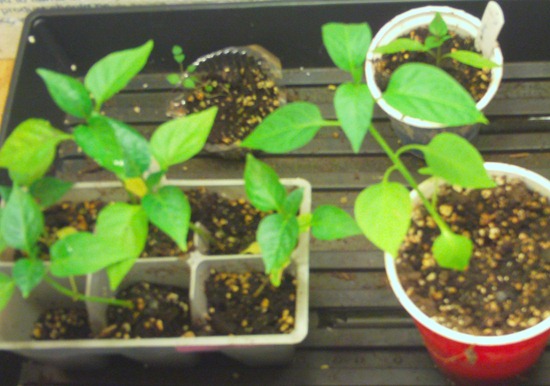When to bring your vegetables outside?
13.1 years ago garlic bulbs, onions, peppers, seeds, spinach, summer, tomato
Every time I have a discussion with a beginner gardener, this is the most common question. Typically the answer involves figuring out your last frost date then doing some backwards math when to start your seeds or purchase your plants from your local nursery. The problem with this is there is an assumption of the rate at which temperatures will increase after this no frost date. It doesn’t really matter how many weeks after the last frost when you bring out your tomatoes but the fact that it is over 65° F
This is good for estimation but ultimately it comes down to what temperatures various vegetables can survive and thrive at. This is ultimately when you should decide to start bringing those fragile plants outside. For reference the table below shows these temperatures for various vegetables.
| Vegetables | Thriving Temp Range |
Surviving Temp Range |
| Hot Vegetables eggplants, sweet potatoes, peppers, watermelons, okra, tomatoes |
70° F – 85° F 21° C – 30° C |
65° F – 90° F 18° C – 32° C |
| Warm Vegetables beans, black-eyed peas, cucumbers, melons, sweet corn, squashes |
65° F – 75° F 18° C – 24° C |
50° F – 90° F 10° C – 32° C |
| Cold/Warm Vegetables artichokes, beets, broccoli, brussel sprouts, cabbages, carrots, cauliflower, celery, chard, collards, endives, fava beans, fennel, kale, kohlrabi, lettuce, parsnips, peas, potatoes, radishes, rutabagas, spinach, turnips |
60° F – 65° F 16° C – 18° C |
40° F – 75° F 4° C – 24° C |
| Cold Vegetables garlic, leeks, onions, shallots |
55° F – 75° F 13° C – 24° C |
45° F — 85° F 7° C – 30° C |
Now that you know what temperatures your veggies grow best in, unless you can find a news station with a 2-3 month forecast this doesn’t help you too much. Fortunately we have been saving weather data for some time now and with some simple statistics you can make a more logical prediction of when this may occur (compared to last freeze date)
One site that makes this very easy is WeatherSpark, it uses historical data with great visuals to easily determine when the best probability of picking the right date to plan on your veggies going out into the great unknown.
As you can see in my area we rarely stay in the thriving temperature zone during a 24 hour period which is the reason why I personally keep my tomatoes and peppers in my automated grow box as long as I can.
Hopefully WeatherSpark can give you some incites about predicting the best times to bring those veggies out for a successful crop this year.
Tags: seed, starting seedling
Starting seeds in paper towels
13.9 years ago indoor seed starting, seeds

Most often I start my seeds in a mix of coconut coir and perlite in seeding cells or small containers, though there are occasions when it may be better to start your seeds in a simple paper towel.
Before going into the benefits first lets go over the technique:
- Get a paper towel, napkin, or coffee filter and spray with water so it is moist (not soaking wet or the seeds could rot)
- Add a few seeds and folder over the paper to cover them.
- Place the paper and seeds into a zip lock bag (I like to use the snack sized ones) and place in a warm location (top or refrigerator, water hearer, etc)
- Check every day or so do see if seedlings have emerged and water as needed
- When seedlings emerge very carefully place the strongest seedlings into dirt cups.
Tips
- Instead of trying to remove the seeds from the paper, you can simply cut around the seedling and plant both into the ground. The paper will eventually erode away without affecting the seedling.
- You can also use this technique to plant the seedling right into the ground.
This technique is great for many reasons:
- Allows for faster germination rates and times
- Great if you have limited space for seedlings (stack of zip lock bags take up much less space than 40/50 seed cells)
- More consistent moisture
- Less dirt on your counters
- Great option for rare, poor germination rates and/or very slow germinating times (think hot peppers with 3-4 weeks germination delays) With this method you can keep close tabs on the progress and know after a week or two if you need to start some more (or buy some new seeds)
For the home grower this is a great space saving technique and due to the water retention in the bags it is nearly impossible to lose seedlings due to lack of watering.
Tags: paper towel, starting seedling




